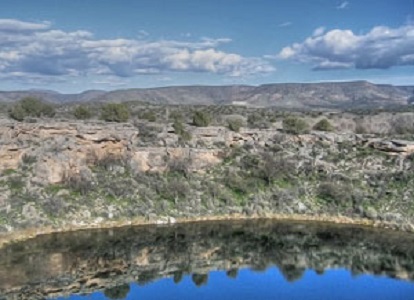
Dan Shouse on Flickr
Organized settlement in the Americas began long before European explorers arrived. Bands of people, some nomadic, others more fixed, moved about the continent leaving behind a rich archeological record that helps to tell the story of where and how they lived. In the Verde Valley of Arizona, Montezuma Castle National Monument protects an impressive cliff dwelling, Montezuma Castle, and a large sinkhole. Montezuma Well, that were important to early peoples as they gradually transitioned from highly mobile societies to more sedentary ways of life.
First constructed during the early 1100s, Montezuma Castle was part of a complex of dwellings built at various times, which the Hohokam and later the Sinagua people inhabited until the Sinagua deserted the entire site around 1425. The five-story, 20-room castle is evidence of an important shift in early American Indian culture from a nomadic to a more settled way of life. Before the Sinagua built Montezuma Castle, various peoples, including the Hohokam, were in the area. The first settlements date from between 1 and 700 AD. The Hohokam seem to have been the first to set up long-term residence. Importantly, the Hohokam appear to have begun either to divide labor into specialized crafts or to develop trading routes. Whether through trade or expert craftsmen, the Hohokam developed a community not based solely on hunting and gathering. They constructed both private and communal pithouses (perhaps for religious ceremonies), but the pithouse dwellings were below ground level and offered little protection against attack.
The Sinagua moved village life up into the cliffs when they constructed Montezuma Castle. Much larger than the individual pithouses, the castle rests on limestone covered with mud. The interior of Montezuma Castle is not open to the public but a paved trail that leads to the base of the site from the visitor center allows visitors to understand the height advantage gained by the Sinagua in moving the settlement from the valley to the cliffs. Living in this protected site, the Sinagua developed a rich material culture that further refined the division of labor present in the earlier Hohokam settlement to include pottery, tools, basketry, and clothing. Many Sinagua artifacts were found near Montezuma Castle in a structure called Castle A against the base of the cliff, part of the progression from living on the valley floor to overlooking it. Because of its greater exposure, Castle A is badly deteriorated, but it once was larger than Montezuma Castle. Artifacts from both Castle A and Montezuma Castle are on display in the visitor center museum.
Large communal dwellings like Montezuma Castle where people occupied close spaces necessitated a shift in how individuals relate to each other and in their food gathering patterns. These shifting patterns were the result of a gradual change from solitary hunter-gatherers to communities composed of larger numbers of individuals living together. These changes would not have been possible in Montezuma Castle National Monument without Montezuma Well. This sinkhole near Montezuma Castle was the source of constant potable water in an arid land. Montezuma Well provided the communities that grew up around it water to drink and to fill a series of irrigation canals begun before 1150 AD and improved by the Hohokam and Sinagua. Some of these canals continue to be used today. The presence of water in the desert supported plant and animal life. The sinkhole attracted previously nomadic peoples to settle in the area by enticing wild game and supporting agriculture in close proximity to a village. Visitors to Montezuma Well can explore this unexpected ecosystem by foot along a half-mile paved trail.
Despite the advantages of castle dwelling and the fresh water from Montezuma Well, inhabitants abandoned both sites for unknown reasons around 1425 AD. When the first European explorers traveled through the Verde Valley in the late 1500s, the Yavapai occupied the castle and sinkhole areas, but they do not appear to have established settlements either as large or as permanent as previous groups. The relationship between the Yavapai and Sinagua is unclear, and changes in the composition of the tribes of the Southwest largely brought about by increased Anglo settlement further confuse who occupied the sites after the 1500s. Today, Montezuma Castle National Monument primarily emphasizes the period of Sinagua settlement, because the castle and well both highlight Sinagua material culture and represent the end of a pre-contact settlement pattern that began on the valley floor and steadily moved up into the cliffs.
Montezuma Castle National Monument is a unit of the National Park Service with two parts. Montezuma Castle is located approximately 45 minutes south of Flagstaff, AZ on Montezuma Castle Road, off Interstate 17, Exit 289. Montezuma Well is also off Interstate 17 at Exit 293 past the towns of McGuireville and Rimrock, AZ. Click here for the National Register of Historic Places file: text and photos. For more information, visit the National Park Service Montezuma Castle National Monument website or call the visitor information line at 928-567-3322.
Montezuma Well and Montezuma Castle have both been documented by the National Park Service’s Historic American Buildings Survey: Montezuma Well, Montezuma Castle. Montezuma Castle National Monument is also one of a number of sites featured in the National Park Service American Southwest travel itinerary.
Last updated: October 29, 2020
